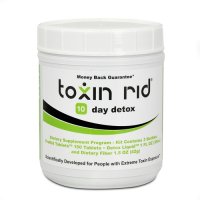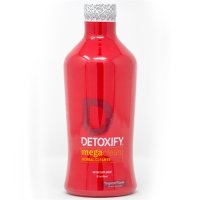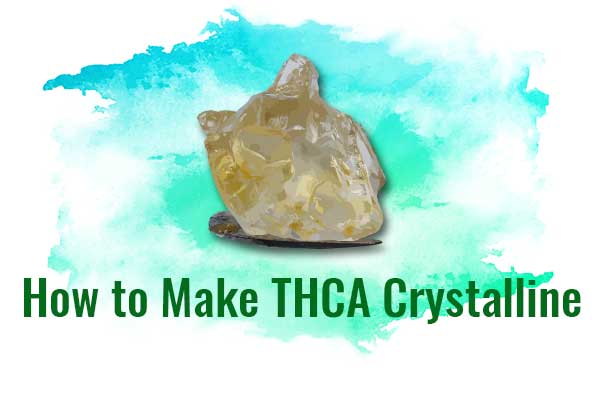Decarboxylation: Best Way to Decarboxylate Weed
What is Decarbing Marijuana?
Did you know that the marijuana plant is not psychoactive? In its natural form, it does not contain THC or delta9-tetrahydrocannabinol which is the most psychoactive component of pot, cannabutter, wax or shatter. What the marijuana plant contains that becomes psychoactive is tetrahydrocannabinolic acid or THCA. The decarboxylation mechanism is heated. Heating converts THCA to THC, then you’re rolling. This happens when we dry the bud, then light it up. The bud contains most of the THCA, with the trim or the leaves containing minimal amounts which can be harvested to make Butane Hash Oil (BHO), cannabutter edibles or canna-oil. If we are not going to burn the dry nuggets in a bong or joint, we will have to decarb our weed by putting it in the oven, even before including it in cooking recipes. The heat removes the carboxyl group from the THCA, creating the psychoactive THC. The same goes for CBDA as heat converts it to CBD.
Decarbed versus Raw Weed
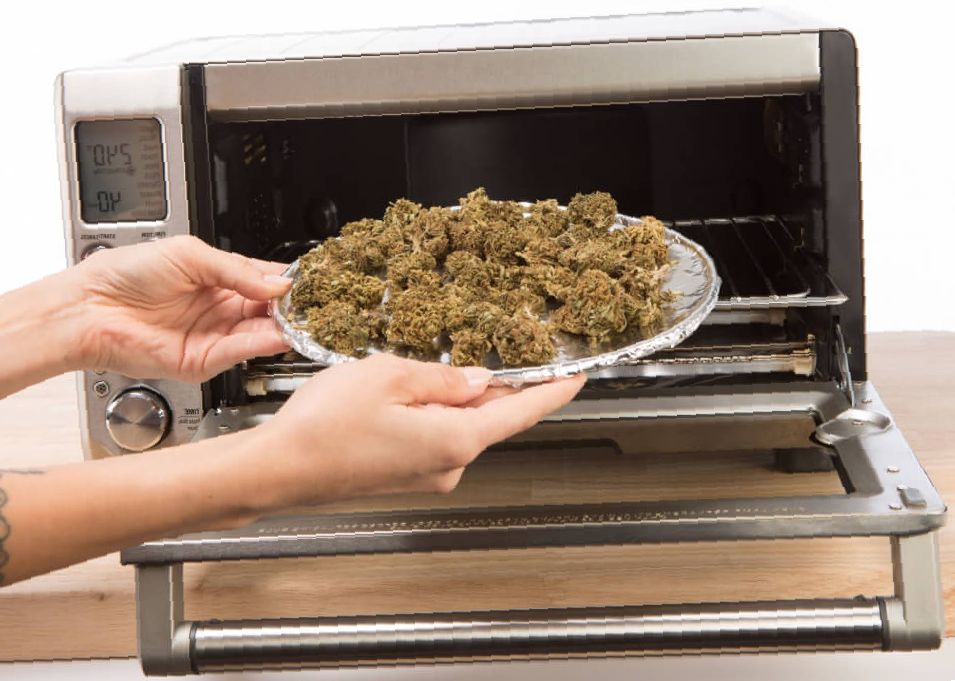
Figure 1.
The reason to use decarbed weed is to activate THC and CBD to get their benefits. However, the raw marijuana plant also has benefits. The terpenes, THCA, and CBDA have anti-inflammatory properties which some users value over psychoactive effects. To use the weed fan leaves or flowers and buds raw, you will need to pick them from a fresh plant. Do not dry and cure them. You will keep the leaves refrigerated. Any portion not used immediately will only last a few days in the fridge. So, it’s best to take your weed directly from the plant and toss it into your hippie smoothie or tea. Be careful with warm drinks as some decarboxylation can occur.
Raw cannabis contains your THCA and CBDA, as well as terpenes and other phytonutrients. These are healthy and provide benefits without being carboxylated. They are also not psychoactive so they can be used in treating ailments in children. Raw cannabis contains over 100 kinds of non-psychoactive cannabinoid acids, THCA being the most abundant. This is why actual marijuana is preferred as a treatment over synthetic THC in Marinol medication, which contains THC alone, without the other therapeutic ingredients in the marijuana plant.
Decarboxylation activates not only the THCA turning it into THC, but also turns CBDA into CBD, and does the same with other cannabinoid acids.



THC Decarb Chart
| Decarboxylation Method Graph | ||
| Method | How Long to Decarb Weed | Temperature |
|
|
|
|
|
|
|
|
|
|
|
|
Decarboxylation Weed Temperature In An Oven
The temperature at which you want to do your decarboxylating will depend on how much time you want to spend in the decarboxylase process. The decarboxylation cannabis temperature will also depend on the kind of flavor you want your weed to have. If you use lower temp for a longer time, you will preserve more terpenes, which gives your weed its smell and taste.
This method is the most common approach used to start the reaction that removes the carboxyl group from your THCA to yield THC:
- Preheat your oven to 220 – 300 degrees Fahrenheit.
- Break your cannabis into smaller pieces with your hands.
- Spread your weed out onto your baking sheet.
- Heat the weed up for 30 to 60 minutes.
- Remove from the oven. Your weed will be browned, hard, and crumbly. Use your hands, a grinder, or food processor to further grind the weed to a coarse grain but not a powder. Now your weed is bursting with available THC, ready to be used for your favorite recipes.
Microwave
Our non-cooking cannabis users have testified that decarboxylation can be done in a microwave. This is a non-preferred method as one cannot be sure the microwaves will not zap some of your cannabinoids or terpenes, but when you smell the result, it is clear that plenty of strong cannabinoids and terpenes remain. Just put in the microwave for 1.5 to 3 minutes on high and you’re done. An advantage of this method is there is far less chance you will burn any of your weed in the microwave. Also, it’s much quicker than other methods.
Sous Vide Decarboxylation Temperature
The Sous Vide method is the brainchild of Sir Benjamin Thompson, an American British physicist. One of his experiments involved even-cooking a mutton shoulder using this method. In short, the weed is vacuum sealed in plastic, then a water-circulating heating element is placed in a pot of water to heat the water evenly. Next, the vacuum sealed weed is placed inside and slow cooked to decarboxylate fully and evenly.
Here’s what you’ll need:
- Vacuum sealing machine
- Weed grinder
- Sous vide precision cooker
- 10-quart pot
- Grind your weed up to a coarse grain but not a powder, be sure to collect any kief produced.
- Seal your weed in heat-safe plastic with your vacuum sealer.
- Place your sous vide precision cooker in your pot filled with water and set the temperature to 200 to 240 degrees Fahrenheit.
- Once the water reaches the correct temperature, add your sealed weed and cook for 1 hr 30 mins to 1 hr 40 mins.
The advantage of this method is that the water circulates to produce an even temperature, all of the weed is cooked evenly and thoroughly providing a consistent amount of THC and CBD throughout. This process also protects your weed from burning on the outside.
Ardent Nova Decarboxylation
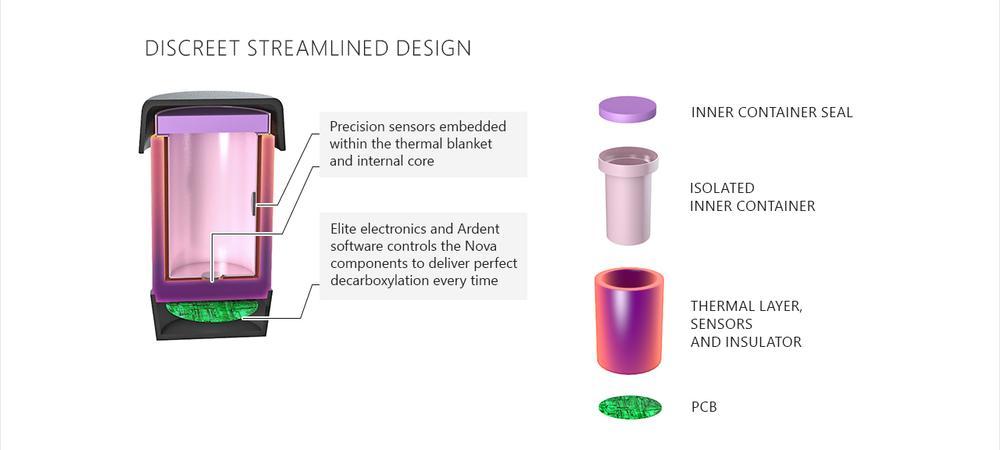



Figure 2.
The Ardent Nova Decarboxylator is a technology made exclusively for decarboxylating weed. It looks a bit like a thermos. It has several advantages over other ways of decarboxylation, including:
- It’s very easy to use. Just put your weed in there, push the button, and in 120 minutes, your weed is thoroughly decarboxylated.
- It doesn’t produce the smell throughout the room of an obvious weed bake, drawing the attention of nosey neighbors and authorities.
- You get to make your own edibles, tinctures, and oils instead of buying expensive pre-made products.
Using the Ardent Nova Decarboxylator is probably the easiest decarb method; however, it will take you 120 minutes to have your fully decarbed product. You can then use your weed in any type of edible, or you can put it in capsules and swallow it, though this will produce the lesser effect and could cause stomach upset. Better it is to extract it into cannabutter or a tincture. Read here how to make cannabutter: https://leaf.expert/english/information-for-patients/cannabutter-oil-recipe



Figure 3.
How Long To Decarb Weed
How long it will take to decarb weed depends on your goals and the decarb method. In the oven, you can use a higher temperature and a shorter time, or a lower temperature over a long time. Decarboxylation occurs at temperatures between 200 and 300 degrees. Many weed enthusiasts prefer to decarboxylate at lower temperatures for longer periods of time in order to keep terpenes from evaporating. Terpenes give the weed its smell and provide some therapeutic action. Some of them smell of lemon or lavender. They give the weed a quality of aromatherapy that is central to the action of weed. If you have ever noticed yourself getting high just from smelling your weed, this is the action of terpenes on your memory. It is an effect of classical conditioning. Just as Pavlov’s dogs salivated on hearing the sound of the bell, you feel high just on smelling the terpenes in the weed.
If you decarb in the microwave, cooking time is dramatically shortened. It only takes about 3 minutes to decarboxylate weed. This method is not preferred however because heating can be very uneven, and terpenoids may be evaporated. However, if you are on the go and need a quick fix, pop it in the microwave, throw it in some butter, and wolf it down for quick anti-inflammatory action and pain relief.
With the sous vide method, a longer cook with a lower temperature is preferred. You can use temperatures anywhere from 220 to 240 for 1 hour and 40 minutes. The longer time makes sure all of the weed is decarboxylated. The water immersion method makes sure everything is cooked evenly. The precision sous vide immersion circulator both heats and circulate the water. Just set the temperature and the time and you are ready to go. The vacuum sealing makes sure all the terpenoids and cannabinoids stay in the weed.
Smoking Decarboxylated Weed
You do not need to decarboxylate your weed before smoking it because smoking it decarboxylates it. However, some claim by decarboxylating it first, they get a more potent smoke. However, decarbing in the oven makes the weed too dry and the smoke harsh. Therefore, they heat it gently in the microwave or use the sous vide method so they get a nice decarbed weed which is not extra dry and the smoke is not harsh. If you want to try this method, just heat the weed in the microwave till the smell is extra potent, from 1 to 3 minutes. Let us know what your experience is!
